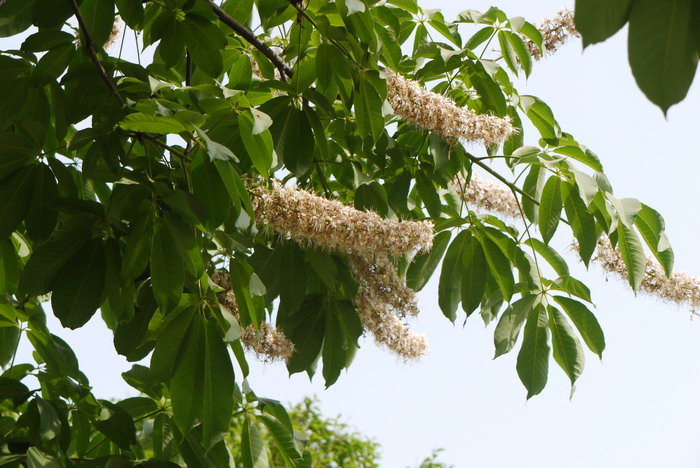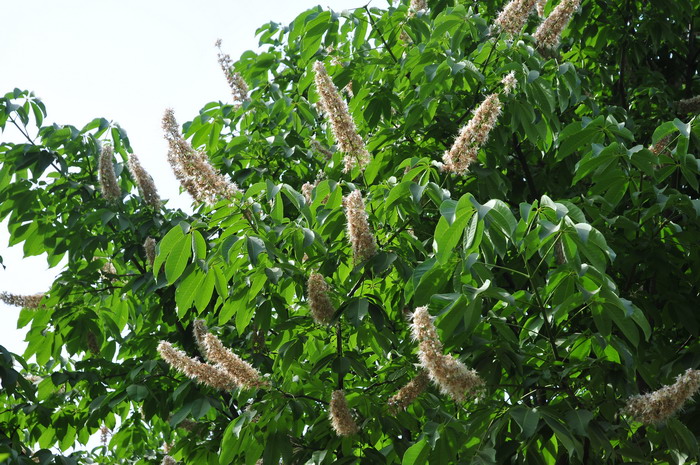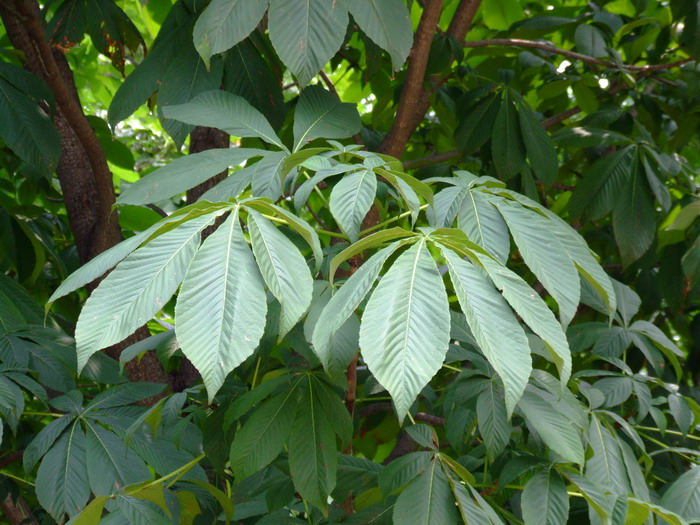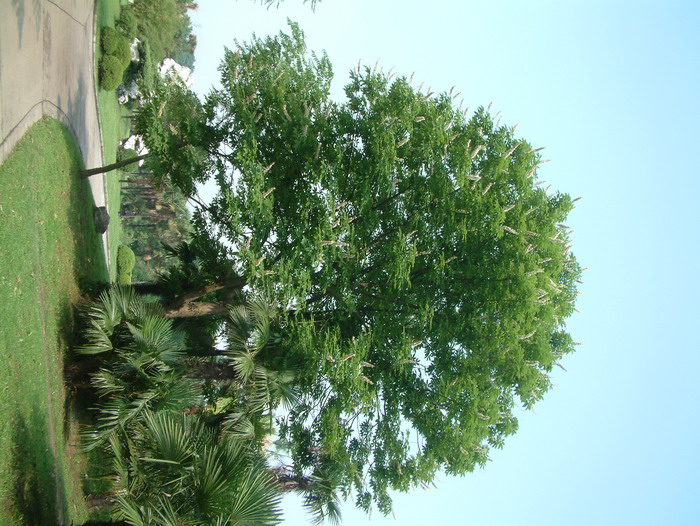七叶树Aesculus chinensis
中文名(Chinese Name):七叶树
学名(Scientific Name):Aesculus chinensis Bunge
英文名(English Common Name):
别名(Chinese Common Name):娑罗子
异名(Synonym):Pawia chinensis Kuntze
科属(Family & Genus):七叶树科(Hippocastanaceae)七叶树属
形态特征(Description):落叶乔木,高达25米,树皮深褐色或灰褐色,小枝、圆柱形,黄褐色或灰褐色,无毛或嫩时有微柔毛,有圆形或椭圆形淡黄色的皮孔。冬芽大形,有树脂。掌状复叶,由5-7小组成,叶柄长10-12厘米,有灰色微柔毛;小叶纸质,长圆披针形至长圆倒披针形,稀长椭圆形钾先端短锐尖,基部楔形或阔楔形,边缘有钝尖形的细锯齿,长8-16厘米,宽3-5厘米,上面深绿色,无毛,下面除中肋及侧脉的基部嫩时有疏柔毛外,其余部分无毛;中肋在上面显著,在下面凸起,侧脉13-17对,在上面微显著,在下面显著;中央小叶的小叶柄长1-1.8厘米,两侧的小叶柄长5-10毫米,有灰色微柔毛。花序圆筒形,连同长5-10厘米的总花梗在内共长21-2 5厘米,花序总轴有微柔毛,小花序常由5-10朵花.组成,平斜向伸展,有微柔毛,长2-2.5厘米,花梗长2-4毫米。花杂性,雄花与两性花同株,花萼管状钟形,长3-5毫米,外面有微柔毛,不等地5裂,裂片钝形,边缘有短纤毛;花瓣4,白色,长圆倒卵形至长圆倒披针形,长约8-12毫米,宽5-1.5毫米,边缘有纤毛,基部爪状;雄蕊6,长1.8-3厘米,花丝线状,无毛,花药长圆形,淡黄色,长约1-1.5毫米;子房在雄花中不发育,在两性花中发育良好,卵圆形,花柱无毛。果实球形或倒卵圆形,顶部短尖或钝圆而中部略凹下,直径3-4厘米,黄褐色,无刺,具很密的斑点,果壳干后厚5-6毫来,种子常l-2 粒发育,近于球形,直径2-3.5厘米,栗褐色;种脐白色,约占种子体积的1/2。花期4-5月,果期10月。
分布(Distribution):河北、山西、河南、陕西均有栽培,仅秦岭有野生的。
用途(Use):优良的行道树和庭园树。
引自中国植物志英文版FOC Vol. 12 Page 2, 3, 4
Aesculus chinensis Bunge, Enum. Pl. China Bor. 10. 1833.
七叶树 qi ye shu| Hippocastanaceae | Aesculus
Trees to 25 m tall, to 2.5 m d.b.h. Branchlets glabrous or puberulent to densely villous when young. Petiole 7-15 cm, grayish puberulent or glabrous; leaf blade 5-7(-9)-foliolate; petiolules 0.5-2.5(-3) cm, grayish puberulent or glabrous; leaflet blades oblong-lanceolate, oblong, oblong-oblanceolate, or oblong-obovate, 8-25(-30) × 3-8.5(-10.5) cm, abaxially glabrous, grayish tomentose on veins (sometimes only when young), or ± uniformly grayish tomentose or villous, base cuneate to broadly so, rounded, or slightly cordate, margin serrulate or crenulate-serrulate, apex abruptly acuminate; lateral veins in 13-25 pairs. Inflorescence puberulent or glabrous; peduncle 5-10 cm; thyrse cylindric, 15-35 cm, 2.5-12(-14) cm wide at base; branches 2-4(-6) cm, 5-10-flowered; pedicels 2-8 mm. Flowers fragrant. Calyx 3-7 mm, abaxially puberulent or glabrous. Petals 4, white, with yellow spots, subequal, oblong-obovate to oblong-oblanceolate, 8-14 × 3-5 mm, abaxially puberulent. Stamens 6 or 7, 18-30 mm; filament glabrous; anther 1-1.5 mm. Style glabrous or villous except at apex. Capsule yellowish brown, ovoid, globose, obovoid, or pyriform, 3-4.5 cm, densely dotted but smooth; pericarp 1-6 mm thick after drying. Seeds 1 or 2, brown, globose or subglobose, 2-3.5 cm in diam.; hilum white, occupying less than 1/3 to ca. 1/2 of seed. Fl. Apr-Jun, fr. Sep-Oct.
● Broad-leaved forests, near streams in tall shady forests, woods, thickets, mountain and hill slopes, ravines, roadsides, also cultivated; below 2000(-2300) m. Native in Chongqing, S Gansu, N Guangdong, Guizhou, SW Henan, W Hubei, Hunan, W Jiangxi, S Shaanxi, Sichuan, and NE Yunnan; cultivated in Hebei, N Henan, S Jiangsu, S Shaanxi, S Shanxi, and N Zhejiang.
Typical Aesculus chinensis, described from Beijing, is planted, especially in temple grounds and by houses, and is not known with certainty in a wild state. Cultivated plants from S Jiangsu and N Zhejiang were described as A. chekiangensis (reduced to varietal rank under A. chinensis in FRPS), but they are scarcely distinguishable from plants in the Beijing region and in fact have some features that were thought to distinguish A. wilsonii, namely a thinner pericarp and a smaller hilum. Aesculus wilsonii was described from wild plants in Chongqing, W Hubei, and Sichuan, and in its typical form differs from A. chinensis in the above features and in having leaves abaxially pubescent (vs. ± glabrous) with a more rounded base (vs. cuneate). Within the range of A. wilsonii occur numerous intermediates with A. chinensis, as was noted by Hardin (Brittonia 12: 34. 1960), who hypothesized that the latter species might only be a cultivated form of the former. The comment in FRPS about native plants of A. chinensis existing in the Qin Ling mountain range (S Shaanxi) was possibly based on a comment by Rehder (in Sargent, Pl. Wilson 1: 500. 1913), which was questioned by Hardin (loc. cit.), who noted that the specimens he examined from Shaanxi "represent a form of A. wilsonii." Indeed, among the intermediates mentioned above are the same gathering seen by Hardin and another from Mianxian in SW Shaanxi. While extreme forms can easily be assigned to either A. chinensis or A. wilsonii, the existence of so many intermediates makes it impossible to delimit species and difficult even to justify infraspecific taxa. We have therefore decided to recognize one variable species, A. chinensis, but nevertheless to retain a separate status for the wild plants, as var. wilsonii.



 (责任编辑:徐晔春)
(责任编辑:徐晔春)
学名(Scientific Name):Aesculus chinensis Bunge
英文名(English Common Name):
别名(Chinese Common Name):娑罗子
异名(Synonym):Pawia chinensis Kuntze
科属(Family & Genus):七叶树科(Hippocastanaceae)七叶树属
形态特征(Description):落叶乔木,高达25米,树皮深褐色或灰褐色,小枝、圆柱形,黄褐色或灰褐色,无毛或嫩时有微柔毛,有圆形或椭圆形淡黄色的皮孔。冬芽大形,有树脂。掌状复叶,由5-7小组成,叶柄长10-12厘米,有灰色微柔毛;小叶纸质,长圆披针形至长圆倒披针形,稀长椭圆形钾先端短锐尖,基部楔形或阔楔形,边缘有钝尖形的细锯齿,长8-16厘米,宽3-5厘米,上面深绿色,无毛,下面除中肋及侧脉的基部嫩时有疏柔毛外,其余部分无毛;中肋在上面显著,在下面凸起,侧脉13-17对,在上面微显著,在下面显著;中央小叶的小叶柄长1-1.8厘米,两侧的小叶柄长5-10毫米,有灰色微柔毛。花序圆筒形,连同长5-10厘米的总花梗在内共长21-2 5厘米,花序总轴有微柔毛,小花序常由5-10朵花.组成,平斜向伸展,有微柔毛,长2-2.5厘米,花梗长2-4毫米。花杂性,雄花与两性花同株,花萼管状钟形,长3-5毫米,外面有微柔毛,不等地5裂,裂片钝形,边缘有短纤毛;花瓣4,白色,长圆倒卵形至长圆倒披针形,长约8-12毫米,宽5-1.5毫米,边缘有纤毛,基部爪状;雄蕊6,长1.8-3厘米,花丝线状,无毛,花药长圆形,淡黄色,长约1-1.5毫米;子房在雄花中不发育,在两性花中发育良好,卵圆形,花柱无毛。果实球形或倒卵圆形,顶部短尖或钝圆而中部略凹下,直径3-4厘米,黄褐色,无刺,具很密的斑点,果壳干后厚5-6毫来,种子常l-2 粒发育,近于球形,直径2-3.5厘米,栗褐色;种脐白色,约占种子体积的1/2。花期4-5月,果期10月。
分布(Distribution):河北、山西、河南、陕西均有栽培,仅秦岭有野生的。
用途(Use):优良的行道树和庭园树。
引自中国植物志英文版FOC Vol. 12 Page 2, 3, 4
Aesculus chinensis Bunge, Enum. Pl. China Bor. 10. 1833.
七叶树 qi ye shu| Hippocastanaceae | Aesculus
Trees to 25 m tall, to 2.5 m d.b.h. Branchlets glabrous or puberulent to densely villous when young. Petiole 7-15 cm, grayish puberulent or glabrous; leaf blade 5-7(-9)-foliolate; petiolules 0.5-2.5(-3) cm, grayish puberulent or glabrous; leaflet blades oblong-lanceolate, oblong, oblong-oblanceolate, or oblong-obovate, 8-25(-30) × 3-8.5(-10.5) cm, abaxially glabrous, grayish tomentose on veins (sometimes only when young), or ± uniformly grayish tomentose or villous, base cuneate to broadly so, rounded, or slightly cordate, margin serrulate or crenulate-serrulate, apex abruptly acuminate; lateral veins in 13-25 pairs. Inflorescence puberulent or glabrous; peduncle 5-10 cm; thyrse cylindric, 15-35 cm, 2.5-12(-14) cm wide at base; branches 2-4(-6) cm, 5-10-flowered; pedicels 2-8 mm. Flowers fragrant. Calyx 3-7 mm, abaxially puberulent or glabrous. Petals 4, white, with yellow spots, subequal, oblong-obovate to oblong-oblanceolate, 8-14 × 3-5 mm, abaxially puberulent. Stamens 6 or 7, 18-30 mm; filament glabrous; anther 1-1.5 mm. Style glabrous or villous except at apex. Capsule yellowish brown, ovoid, globose, obovoid, or pyriform, 3-4.5 cm, densely dotted but smooth; pericarp 1-6 mm thick after drying. Seeds 1 or 2, brown, globose or subglobose, 2-3.5 cm in diam.; hilum white, occupying less than 1/3 to ca. 1/2 of seed. Fl. Apr-Jun, fr. Sep-Oct.
● Broad-leaved forests, near streams in tall shady forests, woods, thickets, mountain and hill slopes, ravines, roadsides, also cultivated; below 2000(-2300) m. Native in Chongqing, S Gansu, N Guangdong, Guizhou, SW Henan, W Hubei, Hunan, W Jiangxi, S Shaanxi, Sichuan, and NE Yunnan; cultivated in Hebei, N Henan, S Jiangsu, S Shaanxi, S Shanxi, and N Zhejiang.
Typical Aesculus chinensis, described from Beijing, is planted, especially in temple grounds and by houses, and is not known with certainty in a wild state. Cultivated plants from S Jiangsu and N Zhejiang were described as A. chekiangensis (reduced to varietal rank under A. chinensis in FRPS), but they are scarcely distinguishable from plants in the Beijing region and in fact have some features that were thought to distinguish A. wilsonii, namely a thinner pericarp and a smaller hilum. Aesculus wilsonii was described from wild plants in Chongqing, W Hubei, and Sichuan, and in its typical form differs from A. chinensis in the above features and in having leaves abaxially pubescent (vs. ± glabrous) with a more rounded base (vs. cuneate). Within the range of A. wilsonii occur numerous intermediates with A. chinensis, as was noted by Hardin (Brittonia 12: 34. 1960), who hypothesized that the latter species might only be a cultivated form of the former. The comment in FRPS about native plants of A. chinensis existing in the Qin Ling mountain range (S Shaanxi) was possibly based on a comment by Rehder (in Sargent, Pl. Wilson 1: 500. 1913), which was questioned by Hardin (loc. cit.), who noted that the specimens he examined from Shaanxi "represent a form of A. wilsonii." Indeed, among the intermediates mentioned above are the same gathering seen by Hardin and another from Mianxian in SW Shaanxi. While extreme forms can easily be assigned to either A. chinensis or A. wilsonii, the existence of so many intermediates makes it impossible to delimit species and difficult even to justify infraspecific taxa. We have therefore decided to recognize one variable species, A. chinensis, but nevertheless to retain a separate status for the wild plants, as var. wilsonii.
踩一下[0]

顶一下[7]